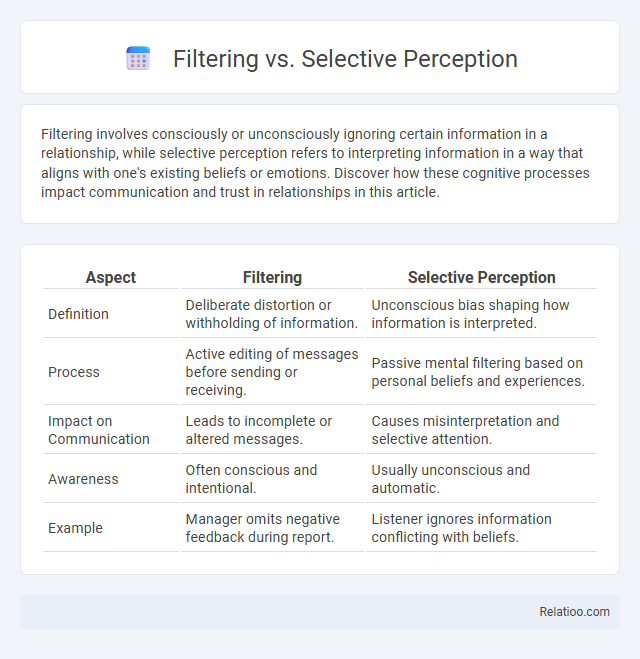Filtering involves consciously or unconsciously ignoring certain information in a relationship, while selective perception refers to interpreting information in a way that aligns with one's existing beliefs or emotions. Discover how these cognitive processes impact communication and trust in relationships in this article.
Table of Comparison
| Aspect | Filtering | Selective Perception |
|---|---|---|
| Definition | Deliberate distortion or withholding of information. | Unconscious bias shaping how information is interpreted. |
| Process | Active editing of messages before sending or receiving. | Passive mental filtering based on personal beliefs and experiences. |
| Impact on Communication | Leads to incomplete or altered messages. | Causes misinterpretation and selective attention. |
| Awareness | Often conscious and intentional. | Usually unconscious and automatic. |
| Example | Manager omits negative feedback during report. | Listener ignores information conflicting with beliefs. |
Understanding Filtering and Selective Perception
Filtering involves the process of screening and prioritizing incoming information based on relevance, allowing only select data to pass through conscious awareness. Selective perception refers to the cognitive bias where individuals interpret information in a way that aligns with their existing beliefs and attitudes, influencing how messages are perceived and understood. Both mechanisms shape communication by managing information intake, but filtering is about controlling exposure, while selective perception affects interpretation.
Defining Filtering in Information Processing
Filtering in information processing refers to the cognitive mechanism by which individuals prioritize relevant stimuli while ignoring irrelevant data, effectively managing sensory overload. This process enables the brain to concentrate on specific information that aligns with personal goals, needs, or expectations, enhancing decision-making efficiency. Filtering differs from selective perception, which involves interpreting sensory input based on personal biases, while it specifically emphasizes active exclusion of non-essential information at the initial stage of perception.
What is Selective Perception?
Selective perception refers to the cognitive process where individuals focus on particular stimuli while ignoring others, influenced by their beliefs, experiences, and expectations. It plays a crucial role in how people interpret information, often leading to biased understanding by filtering data that aligns with existing views. Unlike general filtering, selective perception actively shapes attention and interpretation based on personal relevance and psychological factors.
Key Differences Between Filtering and Selective Perception
Filtering involves consciously or unconsciously ignoring certain information while focusing on specific data, often due to biases or limitations in attention. Selective perception, however, is the psychological process where individuals interpret information based on their existing beliefs, attitudes, or experiences, shaping how they perceive reality. The key difference lies in filtering being an active exclusion of stimuli, whereas selective perception alters the interpretation of information that is already received.
Psychological Mechanisms Behind Filtering
Psychological filtering involves unconsciously prioritizing certain stimuli while ignoring others, shaping your perception based on mental biases and emotional states. Selective perception, closely related, refers to the active process where you interpret information in a way that aligns with your beliefs and expectations. These mechanisms work together to filter sensory input, influencing how your brain processes reality and impacting decision-making and memory retention.
Factors Influencing Selective Perception
Selective perception is influenced by factors such as individual experiences, motivations, and expectations, which shape how information is interpreted and prioritized. Filtering involves the subconscious or conscious process of excluding irrelevant stimuli, while selective perception specifically relates to the active focusing on certain aspects based on personal biases and needs. Cognitive biases, cultural background, and emotional states further affect selective perception, determining which sensory inputs are noticed or ignored.
Real-World Examples of Filtering vs Selective Perception
Filtering involves consciously or unconsciously ignoring irrelevant information to focus on specific data, such as a customer filtering through product reviews to find those mentioning durability. Selective perception refers to the tendency to interpret information based on existing beliefs or expectations, like a political supporter only acknowledging news that favors their candidate. Real-world examples include hiring managers filtering resumes by keywords to shortlist candidates, while simultaneously exhibiting selective perception by favoring applicants with similar backgrounds or experiences.
Impacts on Decision-Making and Communication
Filtering narrows information by excluding certain details, which can lead to biased decision-making and hinder effective communication by providing an incomplete picture. Selective perception causes individuals to interpret information based on personal beliefs and expectations, resulting in miscommunication and skewed judgments. Both processes impact decision-making by limiting the accuracy and breadth of information available, ultimately affecting the clarity and effectiveness of communication strategies.
Overcoming Bias from Filtering and Selective Perception
Filtering and selective perception are cognitive biases where you unconsciously prioritize information that aligns with your beliefs, leading to skewed interpretations. Overcoming these biases involves consciously seeking diverse perspectives and verifying data through critical thinking and fact-checking. Training your mind to recognize and question automatic filters enhances objectivity and improves decision-making accuracy.
Practical Tips to Improve Objective Information Processing
Filtering, selective perception, and filtering biases shape how your brain processes information, often distorting reality. To improve objective information processing, practice mindfulness by consciously recognizing and questioning your biases, actively seek diverse perspectives, and verify facts using reliable sources. Implement structured decision-making frameworks that emphasize data-driven analysis over emotional reactions to reduce the impact of cognitive distortions.

Infographic: Filtering vs Selective Perception
 relatioo.com
relatioo.com